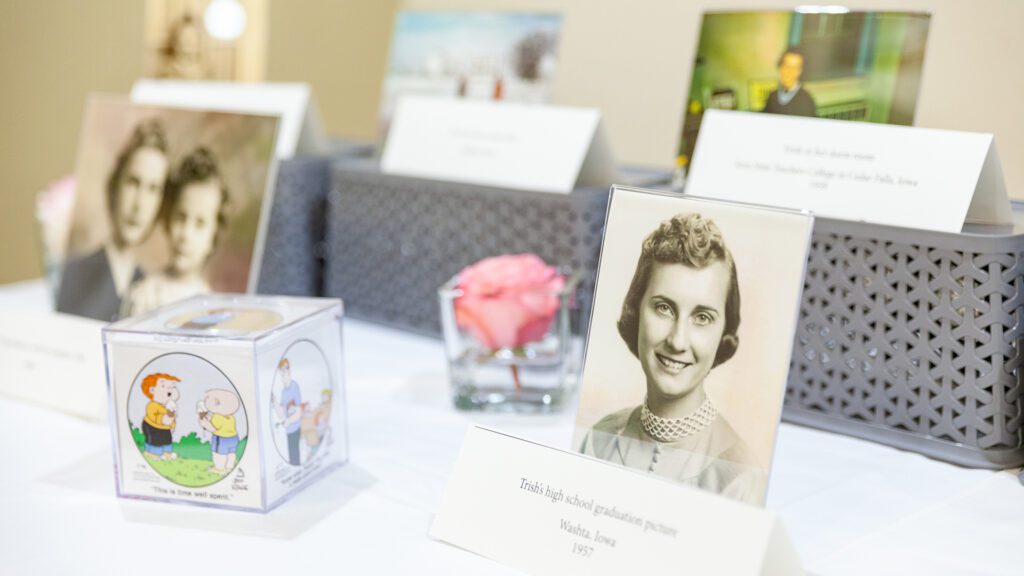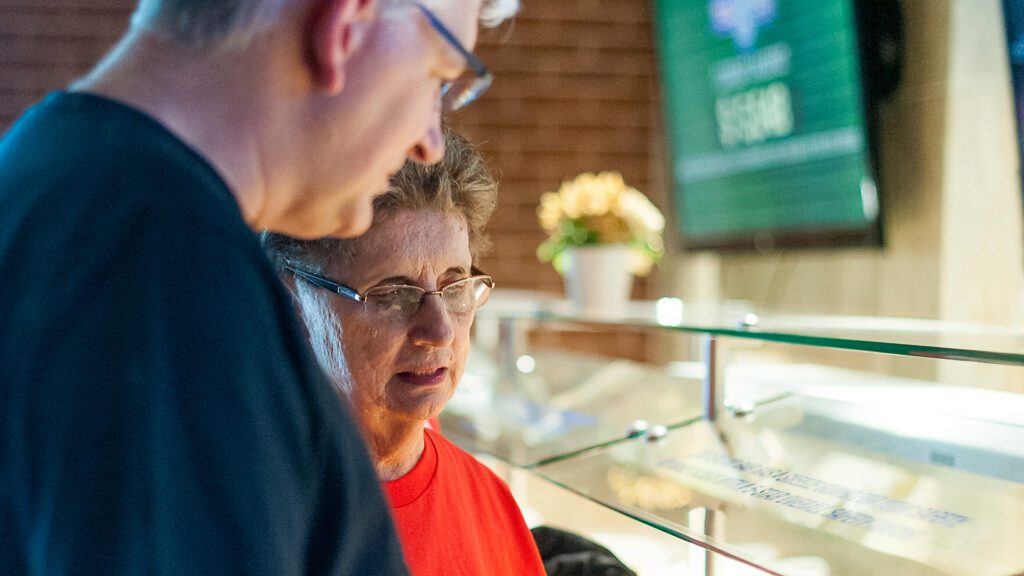Ambiguous Loss and Dementia
 Submitted by Eric Kolb
Submitted by Eric Kolb
Executive Director
Songs & Smiles
My wife, Sheryl, and I personally experienced the ambiguous loss of dementia. We just didn’t know it at first.
We had been helping care for Sheryl’s mom, Trish, for many years. We saw Alzheimer’s slowly steal away parts of who Trish was. As the disease progressed, we had been able to move her into a local memory care facility. She was safe and secure, and we could visit her often, but we both felt a sense of overwhelming sorrow.
Then, Sheryl discovered a book by Dr. Pauline Boss, an educator and researcher recognized for her groundbreaking research on the theory of ambiguous loss. Dr. Boss pioneered the field in 1973, and in 2011 she published a book called Loving Someone Who Has Dementia.
I remember Sheryl reading the first few pages of that book, then pausing to tell me: “This is what I’m feeling. I’m dealing with ambiguous loss.”
What Is Ambiguous Loss?
Ambiguous loss is a loss without clarity, closure, or consolation. It’s a loss that creates confusion, freezing the grieving process. Think of a military family with a loved one missing in action. Think of parents of a kidnapped child. Think of families with loved ones who have gone missing during a natural disaster. These losses make it difficult to cope and find meaning.
Dementia creates ambiguous loss. Your loved one is here, but not here. It’s confusing. There’s no timetable, so no sense of closure.
When you’re caring for a loved one living with dementia, you know something is lost. You see it and you feel it, but it’s not the same as when a loved one dies. Nobody comes to you to validate your loss, to comfort and console you.
When a loved one dies, people tell you how sorry they are. They send cards and cook casseroles. You have a service.
When a loved one is living with dementia, many people don’t seem to know what to say or what to do.
Causes of Caregiver Stress
Dementia caregivers often find resources stretched thin. You don’t have enough time or money to provide all the care you want to give.
Many caregivers, however, are most distressed by the uncertainty and ambiguity involved with:
- not being able to ease the suffering
- not having control over their own lives
- not knowing what role to play
- not knowing when it will end
- not knowing whether they are doing a good job
Sometimes the uncertainty feels worse than the day-to-day challenges of providing care.

Learning to Better Accept Ambiguity
People are naturally resilient. We all live and cope with ambiguity. In her book, Dr. Boss suggests several ways we can increase our tolerance for ambiguity. For me, it was especially helpful to:
- Learn to say goodbye each time you see a new loss.
- Learn both-and (not either-or) thinking, recognizing contradictory ideas can both be true.
These ideas aren’t magical. They won’t fix everything, but they may help you find more meaning during your caregiving journey. Let’s take a closer look at these concepts and see how they might help.
Saying Goodbye
When you see parts of your loved one slipping away, take time to grieve. The loss is real.
For example, when your loved one is no longer able to travel, recognize that as a real loss. Take some time to think about trips they have made, family gatherings they have attended. Perhaps spend some time looking at old photographs.
When your loved one can’t remember someone in your family, the loss is real. If your loved one can no longer remember you, the loss is real and painful. It’s okay to cry. Say goodbye as you cherish all the love you have shared.
It may be helpful to mark your loss with a simple symbolic gesture. You might light a candle, spend a few moments contemplating your loss, then extinguish the flame. You might place a small token in a memory box. You might listen to a song related to your loss.
“Both-And” Thinking
Sometimes, two seemingly contradictory ideas can both be true.
For example, it can be easy to wonder if your loved one is still here or not. You’re trying to make sense of things, so you want to know which is true. Instead, recognize that your loved one is both here and gone.
Here’s another helpful both-and statement. You are both caregiver and a person with needs.
Take a moment to consider what both-and statements apply to your current situation.
Facing the Journey With Joy
Sheryl and I started learning to recognize real loss, grieving along the way. We grieved when we realized we could no longer take Trish on overnight trips. We grieved when she could no longer pick out her own clothes. Trish had been an elementary school teacher; we mourned when she lost her ability to spell.
We learned “both-and” thinking, recognizing that two contradictory ideas can both be true at the same time. We learned to remind ourselves things such as:
- Mom is both here and not here.
- We are both caregivers and spouses.
Perhaps the most important lesson that we learned was that the journey can be both challenging and rewarding. Life can be filled with both sorrow and joy.
Yes, we learned to face Alzheimer’s with songs in our hearts and smiles on our faces.
No, that’s not how we began.
Trish was diagnosed with memory loss in 2008. That was just two years after we lost my wife’s grandmother to Alzheimer’s, so we already knew something about the disease and how tough it could be. We weren’t thinking about joy. We were thinking “here we go again” and asking, “why her?” and “why us?”

Lessons Learned
Trish was an elementary school teacher for more than 20 years. She taught children how to read and write, but even more importantly, she taught children many essential life lessons.
Even as her memories slipped away, Trish continued to tell stories about children learning how to share with each other, respect each other, and value time spent with family. She believed students should do most of their work during the school day, so they could focus their evenings and weekends not on doing homework, but on being with family.
When Trish was first diagnosed with memory loss, she told us she planned to remain positive and to try and make the most of each new day. She was making a choice to approach the disease with a positive spirit. She also was teaching her family and friends how best to face the challenges ahead.
Confused, Frustrated, and Scared
So, Trish decided to be positive. That’s wonderful, but that’s also very hard to do when you have Alzheimer’s. When you can’t remember what just happened, it’s easy to become confused, frustrated, and scared.
The disease typically progresses slowly and gradually, and it did for Trish. The good side of slow progression is that people often can continue certain activities for many years. The bad side of slow progression is that it means things can sneak up on you. One day you wake up and you can no longer do something you’ve done for most of your life … perhaps cook a meal, drive a car, or have a meaningful conversation with your spouse or your child.
It’s hard for the rest of the family, too. The person you once knew seems to be slipping away, and there isn’t anything you can do to stop it. Learning to face Alzheimer’s is tough. That’s why so many family caregivers also end up feeling confused, frustrated, and scared.
Steps Toward Joy
The pain is real, but the pain is only part of the journey. The Alzheimer’s journey also can contain joy.
At the start, when you are trying to make it through days of sorrow and struggle, it may be all you can do to find tiny moments of joy. Sometimes those moments are your lifeline to another day. When you glimpse a bit of joy, then look for ways to create more moments of joy. Those moments can lead to more and more times of joy.
As our family learned to cherish and celebrate moments together, we kept discovering joy around every corner. We started planning more family gatherings. When someone had a birthday, we got together for a meal or dessert. If someone in the family was graduating or getting married, we made the trip to help mark the occasion. And we always took the camera along, capturing moments to help keep memories alive for as long as possible.
When the Texas Rangers made it to the World Series in 2010, we didn’t waste the opportunity. Trish had followed the Rangers since the mid-1990s when Sheryl and I both spent time working for the team’s front office. We knew we had to go, and we knew we had to take Trish.

Creating Moments of Joy
Alzheimer’s never slows down. It never goes away. So we still had plenty of hard days and sad times.
We took Trish on trips for as long as we could, knowing she would eventually not be able to travel. She made her last overnight trip in 2015, visiting family in Missouri. After that, it was more important for Trish to maintain a daily routine and sleep in her own bed each night.
But as we worked to create moments of joy, we gained new perspective. Frustration was starting to be replaced by gratitude. Our family was learning to face Alzheimer’s with joy.
When you start to choose joy instead of fear, you learn to celebrate those moments where joy spills over into smiles and laughter and that feeling of wanting to sing and dance. (We strongly believe that music matters.) At the same time, you learn that joy is much more than those moments. Joy is more than a feeling. Joy is a deep sense of believing everything will be okay, even when it doesn’t feel that way.
Learning From a Teacher
Trish did face Alzheimer’s with a positive spirit. As her memory started to slip, she looked for ways to help herself manage daily tasks. When something helped, she kept at it.
She made lists and kept a calendar handy. She learned to write things down while she was still on the phone, not after she had hung up. And she wrote the most important notes and reminders on a whiteboard hung prominently on a wall in her kitchen.
We recognized right away that Trish was using many of the skills that had made her such a good elementary school teacher. Her whiteboard reminded us all of the creative and well-organized bulletin boards she used in her classrooms.
As Trish used her teaching skills, she was teaching all of us that it was okay to look for new ways of doing things. In fact, as her Alzheimer’s progressed, we had to look for new ways of doing things.
Sheryl and I talked with doctors and read many good books about Alzheimer’s, but our best teacher during the Alzheimer’s journey was always our own experience. We learned from Trish and from our interactions with her. Often, we learned by trial and error, but always we kept learning.
Through her words and her example, Trish was teaching us to persevere, believing everything will be okay even when it didn’t feel that way. She was teaching us to face Alzheimer’s with joy.
Grieving Along the Way
Your journey as a caregiver is not an easy one. The loss you are experiencing is real. Your loss is complicated, so your grief is complicated.
Consider how you might grieve along the way. Share your feelings with others. Write your thoughts in a journal or diary. When you experience a new loss, use symbols or rituals to help you say goodbye. As a family, share a moment of silence in recognition of your loss.
Allow yourself to grieve, even as you allow yourself to love and care.
 Submitted by Eric Kolb
Submitted by Eric Kolb
Executive Director
Songs & Smiles
Eric Kolb is the Executive Director and Co-Founder of Songs & Smiles, a 501(c)(3) nonprofit charitable organization supporting all who love and care for someone living with Alzheimer’s or other forms of dementia.

